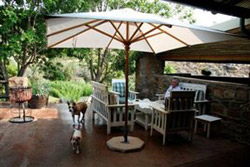Photographs of Paardeplaats Nature Retreat Lydenburg
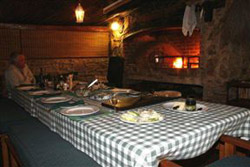
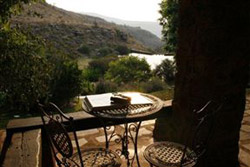
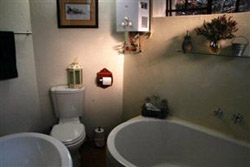
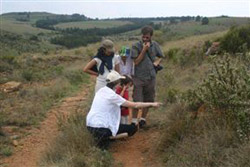
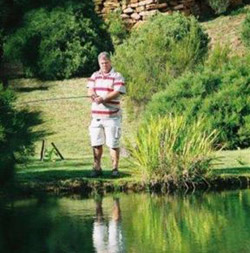
Paardeplaats Nature Retreat Prices
| from/per night | |
| Room type | R |
| Room type | R |
| Room type | R |
| Check in / out times |
| Check-In Times: |
| Check-Out Time: |
| Checking-In & Out Times must be adhered to. |
| For late arrivals please let us know when making your booking. |
Search
Places to stay in
South Africa
|
![]() Email
Paardeplaats Nature Retreat Reservations: booksa@madbookings.com
Email
Paardeplaats Nature Retreat Reservations: booksa@madbookings.com
Remember the pre 1970 Kruger Park ambience? No commercial noise, no cash registers. The smell of fresh air, wood smoke, paraffin and creosote. The singing of birds and the cry of the jackal. The laughter of children at play, while you cook a delicious meal on an open fire, and the friendly, helpful staff to escort you, on arrival, to your comfortable, clean rooms. Add to this stunning escarpment views, the freedom, peace, quiet
and safety of unspoilt nature, where the children can take Ouma
and Oupa for safe, short nature walks. |
|
This is what we like to call “Elegant Simplicity” and “Family Therapy” à la Paardeplaats Nature Retreat!
On the spectacular Longtom Pass (Route 37), along the very tracks of Sir Percy Fitzpatrick and his dog Jock, lies Paardeplaats Nature Retreat, some 12 km from Lydenburg/Mashishing, en route to Sabie.
Set high up in the Mpumalanga Drakensberg, at 2000 meters above sea level, with an annual rainfall of over 1000mm per annum, this 770 ha proclaimed nature reserve, is a haven for birders, hikers and serious nature lovers, who enjoy “elegant simplicity”, so different from the city norms.
Paardeplaats Nature Retreat Accommodation
Built on the ruins of an 1870 miners settlement is the restored 15 sleeper stone dwelling, set in total privacy, overlooking a small trout dam and a beautiful valley and mountains. Hidden amongst trees and the mining terraces are three restored stone units. Each room has a private view with its own unique character with stained glass windows.
All 6 bedrooms are en suite, with down or wool duvets on all the beds. Meals are prepared in the communal “Miners’ Canteen” with a kitchen so well equipped that even professional chefs comment on it. Wood and gas stoves, two gas fridges and utensils to cater for up to 20 people, guarantee a farm style cooking experience with most modcons (except a microwave).
When weather permits, the outdoor, covered, cooking hearth and large veranda is the place to relax and braai, soothed by the sound of running water and bird song.
The fly-fisherman could be tempted to catch a trout, casting almost from the veranda.
The Jafrie Walking and Cycling Ramble is ideal family therapy for those who love nature. The not-so-lazy could pack a picnic basket or a rucksack and embark on one of seven different marked out walking or mountain biking trails, totalling 25km, or just amble down to the nearby waterfall, or take a ten minute stroll to the old gold mine shaft.
Accommodation on the Farm
Six en suite rooms, some with private patios, have unique views of the
valley and the trout dam. These rooms were all built on the original stone
foundations of the three different mining ruins, linked with shady stone
pathways, lantern lit at night. All rooms have solar powered reading lamps,
unaffected by Eskom power outages.
Bathrooms (5 showers and one bath) are all equipped with gas geysers, solar lights and cosy oil burning lamps for ambience.
The bed configuration is as follows:
(All beds have four season down and wool duvets – quality linen
and towels are supplied.)
Jafrie (in the Miners Canteen complex): queen size bed, adjacent shower bathroom.
De Waterbak (named after the miners’ water reservoir): extra length king size bed and a “Queen Anne” stove for the cold winter nights with a spacious en suite shower bathroom.
Kiepersol (adjacent to De Waterbak): twin beds and en suite shower bathroom.
Oribi (at miners’ stamp mill): Large room with a view. Four single beds and en suite shower bathroom. Patio for high teas and brilliant sunsets.
Gurneys (downstairs at Stamp Mill complex). Named after the sugar bird): queen size bed with en suite bathroom with large bath. Ample supply of hot water from either the “donkey” geyser or a gas geyser.
Suikerbossie (upstairs at Stamp Mill complex): Large room with magnificent view and private stoep. King size bed, single bed with pull-out kiddie’s bed. En suite shower bathroom.
Catering on the Farm
The Miners’ Canteen with large open veranda and sheltered cooking
hearth is the hub of the Paardeplaats settlement. The comfortable open
plan living area with fireplace, runs into the farm-style kitchen, meticulously
equipped by Brian (ex Dullstroom’s Tonteldoos Bistro).
Catering facilities are flexible and more than adequate for all needs. An ultra reliable antique “Union No 8” wood stove with oven provides the heat and the ambience, and a marvellous challenge to do it the “old way”, with no compromise in quality.
This is supplemented by a three burner gas stove and every possible pot, pan, spatula and whisk a catering chef would need - all hanging from overhead. There are two gas fridges with freezer compartments in the kitchen and an antique evaporative cooler on the veranda to keep your vegetables fresh.
Please note there are no electrical appliances or and no microwave.
Crockery offers a choice of elegant porcelain to miners’ tin plates and mugs, wine and sherry glasses and cutlery for up to 20 pax. For elegance there are linen table cloths and serviettes.
The large covered braai cum cooking hearth offers a creative alternative to the kitchen, seating up to 18 people on the outside veranda. This is a very cosy cooking and dining area with roll-down grass blinds to keep the warmth in when needed. The fire keeps the party going until all hours. This area is lit by paraffin lamps and gas lights at night.
During the day the spacious veranda overlooking the trout dam, is the place to laze in the sun under large umbrellas, around beautiful patio furniture.
Lighting
All rooms have solar powered reading lamps. Use them wisely as the sun
can disappear for a few days at a time. Don’t leave burning when
not needed!
Oil-burning Alladin lamps in all rooms and bathrooms.
Gas and paraffin lamps at the “Miners’ Canteen”.
Paths to all the rooms are lit by hurricane paraffin lanterns.
Four LED lanterns are supplied – own torches would be useful.
Communication
A Space Stream telephone system with internet is available on request
by prior arrangement only. There is no cell phone reception on the farm,
except for a poor reflected signal at a few spots.
Bring Along
We supply towels, linen and basic toiletry requirements.
Being primarily a nature venue, the dress code is of course casual. Bring
clothing for at least two seasons, plus:
Walking shoes / boots
Walking sticks
Small rucksack
Hats
Sunblock
Binoculars
Camera
Torch
Mountain bikes
Books for reading and your “Roberts”
Warm clothes for the evening
BRING ALONG FOR ACTIVITIES:
· We supply towels, linen and basic toilet requirements.
· Being primarily a nature venue, the dress code is of course casual.
Bring clothing for at least two seasons
· Walking shoes / boots
· Small rucksack
· Hats
· Sunblock
· Binoculars
· Camera
· Torch
· Books for reading and your “Roberts”
· Warm clothes for the evening
· For catered courses: your own drinks.
Paardeplaats Activities
The Jafrie Walking and Cycling Ramble:
Hiking and mountain biking for both the serious and not so serious is
a popular pass-time on Paardeplaats.
The Jafrie Walking and Cycling Ramble offers seven different routes totalling
about 25 kilometres. On all routes, the views are rather spectacular with
an abundance of sub-alpine flowers and plants in summer time, and with
wonderful birding and game through all seasons.
Hike at your leisure to the nearby gold mine (10 – 15 minutes), or don your boots and amble down the river to the top of the waterfall (20-30 minutes).
For the more serious hikers pack a picnic bag with some cold beers and sami’s, take your walking stick, your binoc’s and your bird books and tackle one of the longer routes as a group or family.
Sorry, no quads or scramblers are allowed on the farm as the veld is too sensitive. The Jafrie Ramble is ideally suited for mountain biking.
Accommodation is in en suite rooms with views. Dress at all times casual and informal – view all the courses available.
Birding
The farm is covered by patches of a few different types of protea, mainly
the Silver Protea and Common Sugarbush. The Transvaal Beech is also quite
common in the area. Together these are the home and breading ground for
the much sought after Gurney’s Sugarbird, researched by Dawie de
Swardt of the National Museum in Bloemfontein.
Paardeplaats’ Jesus Hill features on the international birding atlas and the Mpumalanga Nature Conservation Map as highly sensitive, because of the sugarbird’s association with these trees. The sugarbirds do not only forage exclusively on the nectar of the flowers, but also use the trees as their main nesting sites.
See our bird-list of about 200 bird species which have been recorded in the Lydenburg area by Dawie in his years of research on the farm and surrounds. Please let us know, and add to this list, if you make a new discovery!
The area close to the Anglo Boer War forts, because of its remote situation, is a popular breeding site for Denham’s Bustards in early spring.Blue Cranes also have a couple of favoured breeding sites on the farm in late spring, early summer. The best is to ask Lucas where they are.
One should keep your distance and be very careful not to disturb them! The garden around the Miners’ Canteen and the bedrooms is home to a host of interesting, different birds – enjoy the early morning symphony. Species such as Barthroathed Apalis, Drakensberg Prinia, Cape White-eye, Cape Robin-chat, Redwinged Starling and Cape Rock Thrushes are resident here.
In winter, look out for sunbirds (Malachite, Greater Double-collared and Amethyst) and of course the Gurney’s Sugarbirds visit the aloes on the nearby krantzes. In the near future we will be setting up a “Vulture Restaurant” opposite the roosting site on the cliffs in “Masjienkloof”, with a hide, for research purposes. Watch this spot for developments!
Mountain Biking
Paardeplaats offers ideal terrain for family mountain bikers on the tractor
roads that criss- cross the farm, with glorious views throughout. So please
bring along your bikes. Sorry, no quads or scramblers allowed on the farm
as the veld is too sensitive.
Fauna and Flora
There are a host of different types of small game to be found on the farm
- grey rhebok, klipspringer, oribi, duiker, rooikatte, jackals, porcupines,
bush pigs, honey badgers, not to mention the darn baboons and vervet monkeys
- all are part of our daily encounters.
There is a migrating herd of eland, totaling about 30 that regularly visit the farm, as well as rare encounters with brown hyena (they are mainly nocturnal) and even leopards. In 2004 there was a mother with two cubs resident in “Masjienkloof”.
All these are complimented by our beloved wild horses, who, legend has it, date back to the Anglo Boer War and before (remember the name of the farm dated September 1874!).
Plant lovers will appreciate the wealth of “fynbos” and sub-alpine indigenous species – Rothmania Capensis, several different proteas, Aloe arborescence, Transvaal bottlebrush, buddleias, and Erica, Agapanthus inapertus, scyzzostyllis, Nerina filifolia, arum lilies, red hot pokers, Brunsvigia natalensis, and several different species of watsonia and gladioli.
There are many different orchids to be found in the wetter areas in summer and are well worthy of interest and research. An orchid, Brownleea Graminicola, is found exclusively on Paardeplaats, under the boulders, on one of the south east facing hills on the farm – very special!
Altitude Training
Paardeplaats, at 2000m above sea level, falls within the high altitude
training requirements, in perfectly safe and secure surroundings. The
annual Longtom Marathon, in March, runs past our gate on the main road
to Sabie. At 12 km from Lydenburg and 43 km from Sabie, groups may book
the facility for self -catering, bed and breakfast or full board accommodation.
Fishing
Although not aimed at the purist or the serious fly-fisherman, the small
trout dam is well stocked with 500g plus fish, and at times is even a
challenge for the expert. If you need a super fresh trout as a starter
for your evening meal, ask Lucas, our very capable fly-fisherman, to oblige
you and to gut it for you. Fish cost R70.00 each, payable to Lucas. Lucas
will happily share his considerable knowledge and skills in fly-fishing
with novices or even the not so “green” – especially
if you reward him financially! Remember it is his off time.
The History
Paardeplaats has several interesting facets to its history:
Prehistory:
Firstly there is the very evident geological pre-history, which resulted
in the deep valleys and cliffs, dating back millions of years. Then there
are traces of the San and the Stone Age, dating back to about 400AD and
before.
Iron Age:
This area is part of an important historical node, dating back at least
1600 years, to the early passage of migrating Nguni peoples who left behind
a remarkable record of their dwellings and terraced farmlands. The famous
“Lydenburg Clay Heads” dating back to 490AD, are from this
period.
Looking down from the top of Masjienkloof, many large stone circles are visible. These were cattle kraals, the smaller stone circle in the centre being where the homestead was situated. These peoples smelted iron and made sophisticated tools from it. The stone circles are always situated at the bottom of the valleys as this was closer to the available water and the climate was warmer and more protected.
Early Transvaal History:
Shortly after the start of the Great Trek in about 1840, the white man
entered this area in search of land and freedom from the “verdomde
Engelse”.
Initially the area around Ohrigstad was very popular because of its fertile valleys and the abundance of good water and game. However, malaria took a heavy toll, and the inhabitants were forced to withdraw to the malaria safe area around Lydenburg – hence the name of the town referring to the suffering the people had experienced.
Between the 1850’s and 1870’s many adventurous, pioneering prospectors, mostly English and Welch, came into the area in search of gold and good fortune. The town of Lydenburg became a popular stop-over for transport riders on their way to and from Delagoa Bay. This was big business and was very much part of Paul Kruger’s obsession to secure a harbour for the ZAR. These rough types were often referred to as “Uitlanders” by the local population.
The original farm diagram for Paardeplaats 154JT is dated September 1870 and is defined in Dutch. The Paardeplaats stone ruins are part of the early gold mining activity in this area. Gold was actively mined from the 1850’s up until the start of the 20 th century. We have discovered 17 worked-out mine shafts on the farm, which have now become shelters and lairs for rooikatte, brown hyenas and even leopards, so don’t even think of exploring them!
The original transport riders’ wagon route over “Mauchs Berg” from Lydenburg to Delagoa Bay, traversed the farm and is still visible on the southern side of today’s Long Tom Pass (Route 37). This is the road that Sir Percy Fitzpatrick and Jock would have used on a regular basis as an alternative to “Robbers’ Pass” via Pilgrims Rest.
![]() Email
Paardeplaats Nature Retreat Reservations: booksa@madbookings.com
Email
Paardeplaats Nature Retreat Reservations: booksa@madbookings.com

 More places to stay around Lydenburg
More places to stay around Lydenburg